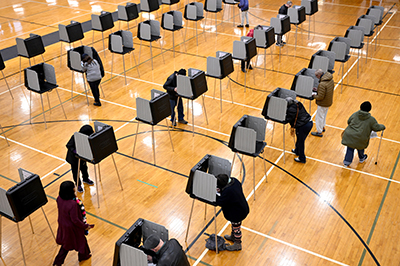AARP Hearing Center
Important dates and election information
Last day to register to vote: Monday, Oct. 7
Early in-person voting: Tuesday, Oct. 8 through Sunday, Nov. 3.
Deadline to request absentee ballot: Tuesday, Oct. 29
Deadline to return absentee ballot: By mail, Monday, Nov. 4 (postmarked); In person, Tuesday, Nov. 5
General election: Tuesday, Nov. 5

Voting at a glance
- Voter registration: The deadline to register to vote for the general election is Monday, Oct. 7. Check your status at the state’s voter information portal.
- Absentee voting: Any registered voter in Ohio can request an absentee ballot without a reason.
- Early voting: Voters can cast a ballot before Election Day at their county board of elections office from Tuesday, Oct. 8 to Sunday, Nov. 3. Check the location and times of early in-person voting with your county board of elections.
- Voting at the polls: Polls are open from 6:30 a.m. to 7:30 p.m. Bring a valid form of photo ID, such as your Ohio driver’s license or U.S. passport.
Recent voting changes in Ohio
A voter may only return their own absentee ballot when using a drop box. According to an August directive from the secretary of state’s office, if you are returning an absentee ballot on behalf of someone else, like a relative or disabled person, you may not use a drop box and must deliver it to the county board of elections in person or by mail. If delivering in person, sign a form at the board office attesting you are acting in compliance with state and federal law.
Laws that took effect in 2023 may change how you vote in the 2024 elections:
- Voters must show a valid photo ID, such as an Ohio driver’s license or U.S. passport, when voting at the polls. Other documents, such as a paycheck, utility bill or Social Security card, are no longer considered valid. If you do not have a valid photo ID, you can obtain a free state ID card at any Bureau of Motor Vehicles deputy registrar license agency in Ohio. More information is available at the BMV website.

- The deadline to request an absentee ballot is seven days before an election. Previously, it was three days.
- Your county board of elections must receive your absentee ballot by mail no later than four days after an election. But your absentee ballot still must be postmarked by the day before an election.
- Early in-person voting is no longer offered on the Monday before Election Day.
Redistricting has changed the boundaries of some U.S. congressional and state legislative districts and may affect which candidates appear on your ballot. Locate your district on the state elections website, where you can find the latest congressional and state legislative maps.
How to register to vote
Register online, by mail or in person.
- Online: Use the state’s voter registration portal to register, check the status of your application or update your registration. You’ll need your current Ohio driver’s license or identification card number and the last four digits of your Social Security number. You may also register or update your personal information while applying for or renewing your Ohio driver’s license. Register online by Monday, Oct. 7, for the general election.
- By mail: Download and print a voter registration form from the state elections website. Or call the Ohio secretary of state’s office toll-free at 877-767-6446, option 4, to request a form. Include either your current Ohio driver’s license number, state identification card number or the last four digits of your Social Security number. Then mail your completed form to your county board of elections. It must be postmarked no later than Monday, Oct. 7.
- In person: Registration forms are available for pickup at the secretary of state’s office, your county board of elections office, an Ohio Bureau of Motor Vehicles office and several other state-designated agencies listed on the secretary of state’s website. Deliver your completed form to your county board of elections by Monday, Oct. 7.
Registering to vote on Election Day
Ohio doesn’t allow same-day voter registration.
Check your voter registration status
You can check your registration status using the state’s voter lookup portal.
How to request an absentee ballot
Any registered voter can request an absentee ballot by mail or by phone without providing a reason.
- By mail: Download and print an absentee ballot application from the state elections website. Include either your driver’s license number, your state identification number, the last four digits of your Social Security number or a copy of your photo ID. Mail your completed application to your county board of elections.
- By phone: Call your county board of elections to request that an absentee ballot application be mailed to you.
Your board of elections office must receive your completed application, whether by mail or in person, by close of business on Tuesday, Oct. 29.
Voters who are hospitalized due to a medical emergency may apply for an absentee ballot until 3 p.m. on Election Day using a separate absentee ballot application. If needed, you can request that your county elections officials deliver your ballot to the hospital.
Returning an absentee ballot
Return your absentee ballot by mail or in person.
- By mail: Mail your completed ballot to your county board of elections. It must be postmarked by Monday, Nov. 4, and received no later than Saturday, Nov. 9, for the general election. Prepaid postage is not provided and postage costs may vary by county.
- In person: Return your absentee ballot to your county board of elections by 7:30 p.m. on Election Day (Tuesday, Nov. 5).
- Drop box: One ballot drop box also will be available outside of your county board of elections office. Only a voter’s personal absentee ballot may be returned via drop box.
Track the status of your absentee ballot at the state elections website.
Voting in person before Election Day
You can vote early and in person at your county board of elections office from Tuesday, Oct. 8, through Sunday, Nov. 3, for the general election. More information will become available at the state elections website closer to the election.
Voting at the polls on Election Day
Polls will be open from 6:30 a.m. to 7:30 p.m. on Tuesday, Nov. 5. As long as you’re in line before the polls close, you may cast a ballot. Find your sample ballot at the state’s website.
Voter ID requirements on Election Day
Bring a valid photo ID, such as an Ohio driver’s license, U.S. passport or U.S. military identification card. A paycheck, utility bill, Social Security card, birth certificate and some other government documents are no longer considered valid under a 2023 law.
Voting with a disability
All polling places in Ohio are required to be accessible to voters with disabilities. If you need assistance marking your ballot because of a disability, two precinct election officials — one from each major political party — may help you. Or you can bring someone to assist you, as long as they aren’t your employer, an agent of your employer or union, or a candidate. You may vote curbside if you’re unable to enter your polling place. A ballot will be brought to you, so you can vote from your car or at the voting site’s door. More resources for voters with disabilities are available at the state elections website.
Voting from a nursing home or long-term care facility
If you are confined to a nursing home or long-term care facility and cannot vote in person on Election Day, you have the option of voting via an absentee ballot.
Editor’s note: This guide was originally published on Dec. 11, 2023, and was updated on Oct. 23, 2024, with information on postage costs for returning an absentee ballot.
Michelle Tuccitto Sullo is a states writer and editor for AARP. She previously served as managing editor of the Hartford Business Journal in Connecticut and has also worked for the New Haven Register, the Connecticut Law Tribune and New Haven Biz.
Elissa Chudwin contributed to this story.
Also of Interest:
- Follow AARP’s political coverage.
- Keep up with local events and AARP advocacy efforts.
- Find voter guides for all 50 states.
- Learn more about AARP's caregiving advocacy work.































































